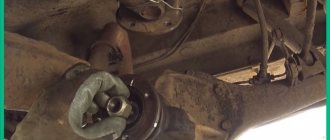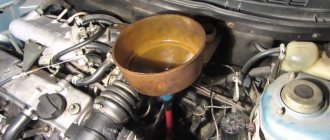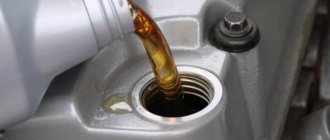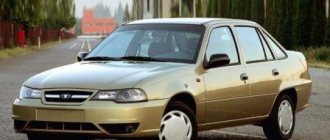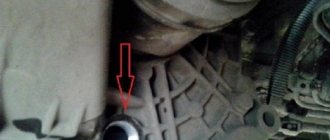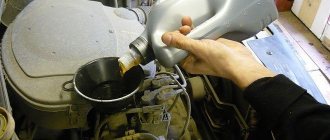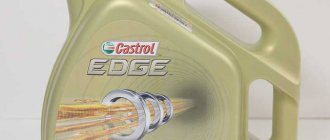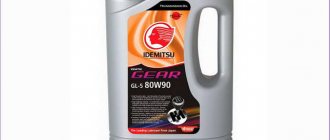First cars VAZ 2110 were released in the summer June 1995 But mass production began in 1996, and these cars went on sale a year later - in 1997 VAZ 2110 was considered a high-class car. It was installed electronic control system, on-board computer, it was additionally possible to install power steering and power windows. With the advent of the VAZ 2110, AvtoVAZ opened a new page in the development of its automobile production.
In order for your car to serve you for many years, it is necessary timely maintenance. One of the components of maintenance in the VAZ 2110 is changing the oil . This is a simple process that even an inexperienced car enthusiast can do, but it still requires care . In this article we will try to look at how to properly change the oil in a VAZ 2110 .
Oil change intervals
Almost any driver knows the regulations for replacing technical fluids in his car, which are established by the manufacturer. But, in addition to the recommended timing, there are cases when the oil needs to be changed “unscheduled”. Such cases include, for example, carrying out a major engine overhaul or running-in. In the latter case, the oil change should occur after 3000 km. This is done in order to eliminate the consequences of break-in, that is, to remove chips from the engine.
Subsequent replacements are carried out after the car “passes” 10-15 thousand kilometers. Considering the quality of motor oils, it is recommended to do this more often, at least once every 8 thousand km.
Remember! The more often the engine oil is changed, the cleaner the engine is from the inside and the longer it retains its service life.
An oil change on a VAZ 2110 with a manual transmission is performed once every 40-60 thousand kilometers, and in an automatic transmission - every 60-80 thousand kilometers.
How much oil to fill (filling volumes)
- Fuel tank size – 43 l (AI 95);
- Cooling system - consumes 7.8 liters of coolant (OZH-40-KHG, OZHK-KHG, OZH-40, OZH-65-HG, OZHKtosol, OZH-65, OZHK-KSK, OZH-40SK, OZH-65SK, OZH -40 Tosol-TS, Lada-A40, OZh-Ktosol-TS, OZh-65 Tosol-TS, Glysantin G 03, Antifreeze G-48, AGIP Antifreeze Extra, Glysantin G 91);
- Engine lubrication – 3.5 l;
- Gearbox - 3.3 l (API classification: GL-4. Viscosity SAE: 85W90, 80W85, 75W90);
- Hydraulic brakes – 0.55 l (DOT 4);
- Windshield washer – 4.5 l;
- Rear window washer – 1.5 l.
Spread the love
Required volume
Before buying motor oil, you need to decide on the volume. The best option is to purchase a 4-liter canister, which will last for a long time. This is convenient, because you can add the remaining liquid as the liquid is consumed, without worrying about buying a new one every time.
Well, now specifically about the one-time filling volume. The engine model plays an important role here. The VAZ 2110 used two engine variations. This is an 8-valve and 16-valve engine. In the first case, the volume of the oil sump is 3.2 liters, and in the second - 3.5 liters.
Manufacturers rating
- The manufacturer installs the Russian-made BIG Filter product on VAZ 2110 cars. According to reviews from motorists, it lasts the guaranteed period until replacement. Not inferior to imported analogues. Available in green (original), blue (VAZ analogue) colors. Not counterfeited.
- The leader of the foreign market is MANN Filter products; original versions are produced by Germany (the rays of an ultraviolet lamp allow you to see the date of manufacture on the lid), licensed versions are produced by South Korea, China, Brazil, and India. Due to its worldwide popularity, there are counterfeit copies. The MAHLE company produces high-quality products and is popular in Russia.
Important! Visiting trusted sellers and branded stores will help you avoid purchasing counterfeits.
Rules for choosing oil
There are three basic rules for choosing engine oil for the “ten”:
- When purchasing, you must be able to distinguish a fake from the original. Counterfeit oils are a real problem in the modern car market. As a rule, those liquids that are counterfeited are those that have a high cost and are produced by famous brands. The use of such motor oils can have a detrimental effect on the engine.
- Every car owner should know about the approvals. Each car has its own motor oil tolerances, which determine the permissibility of using a particular liquid.
- Do not forget about the viscosity of motor oil, which depends on the region of operation, climate and weather conditions.
What to pay attention to
Now let's look at each of the above points in more detail. And first, let's return to fakes and understand the rules for identifying them. The easiest way to recognize it is to look closely at the canister. Even the slightest difference from the original will immediately reveal the efforts of the scammers. Non-original oil is also distinguished by another feature: the absence of a foil protective seal on the filler neck. It should be under the lid. If it is not there, the canister has already been opened, and not real oil was poured into it.
The optimal viscosity of engine oil for the VAZ 2110 is 5W40. Especially if the car is used with low mileage all year round. If the car is used quite often, for example in a taxi, then the oil should be selected according to weather conditions. In Russia, it is recommended to pour 0W30 in winter, and 10W40 or 15W40 in summer.
On a note! Sometimes, as an alternative to oil, regular mineral water is poured after break-in to save money.
A brief overview of the best motor oils
If a car owner finds it difficult to choose motor oil, it is recommended to pay attention to the following brands:
- Lukoil Lux. This is the cheapest motor oil for the VAZ 2110. It is recommended for use in cars with high mileage. Lukoil Lux is an ideal option for topping up, since the price of a liter canister is only 250-300 rubles. The oil has good cleaning properties, and, most importantly, no one will counterfeit a cheap liquid. After all, you must agree, this is unprofitable.
- Shell Helix HX8. This is a fairly high-quality oil for VAZ engines. Shell Helix has excellent lubricating properties and is ideal for all types of engines. It is more advisable to use this type of lubricant in an engine after a major overhaul or with a mileage of up to 200 thousand kilometers. In other cases, using this oil is a very dubious pleasure, since the price of a 4 liter canister is 2000 rubles.
- Elf. Not long ago Elf left the Renault assembly line, but was remembered as a good motor oil. Car owners began to pour it not only into popular foreign cars, but also into VAZ and
- Lada 110. To have a good effect, it is recommended to change Elf more often than required by the regulations. Ideally, it is recommended to reduce the frequency to 7-8 thousand kilometers.
We wash the power unit
Flushing oil Lukoil
It is recommended to periodically flush the inside of the engine according to the following instructions:
- After draining the oil, screw the plug back into place.
- Fill the engine with flushing fluid to the minimum mark on the dipstick.
- Start the engine and leave it running for 10-15 minutes.
- Drain the liquid.
- Unscrew the filter using a wrench or do it by hand.
- Wait until the oil drains completely from the engine.
Oil change methods
Changing the lubricant can be done in two ways:
- with flushing;
- without rinsing;
The first is relevant when completely replacing the fluid and switching, for example, to another manufacturer.
With engine flush
Depending on the type of flushing, replacing engine oil can be divided into two types:
- 5 minutes. This is the most popular type of flushing. How is everything going? A special cleaning fluid is added to old motor oil. Then the motor is started for 5 minutes and allowed to run without load. After this, the old oil is drained along with the flush. This method is good because the old lubricant becomes more liquid and is easily removed from the engine along with the dirt.
- use of flushing oil. The use of this flushing option when performing a procedure such as changing the oil on a VAZ 2110 is performed as follows: the old oil is drained, then the oil filter is changed, and flushing fluid is poured into the engine. After this, the car must be driven a certain distance without heavy load. Then this oil must be drained and replaced along with the filter. This is a more expensive and high-quality type of washing.
Attention! Flushing the engine is done at your own risk. The fact is that caustic substances can raise coked dirt in layers and clog oil channels. Because of this, the oil pressure in the engine may drop. This is especially dangerous for 16 valve engines. In order to properly flush the engine and fill in a new type of engine oil, it is recommended to use a longer flush.
No engine flushing
If the type, brand and model of engine oil does not change, then the replacement is performed without flushing. To do this, the old oil is drained, the filter is unscrewed, a new one is installed and fresh lubricant is poured in. You don't need to do anything else.
Execution of work
The need for replacement is determined:
- mileage (frequency indicated by vehicle documentation);
- season (winter, summer);
- visually - with a finger laboratory (checking the level with a dipstick, paying attention to color, viscosity, smell, contamination).
Step-by-step instruction:
- Place the machine in a specially prepared place;
- Warm up the engine;
- Place the pan under the crankcase;
- Open the neck, avoiding the appearance of a vacuum effect;
- Carefully, observing safety precautions, unscrew the plug;
- Waiting 15 - 30 minutes for complete drainage, start replacing the cleaning unit;
- Fill the new product halfway (about 100 ml) with fresh oil;
- Lubricate the O-ring;
- Screw on the plug;
- Screw in the device by hand, performing 4-5 turns after the stop, overcoming the elasticity of the gasket;
- Restore the cleaning fluid level;
- Check the successful completion of operations using the light on the dashboard by starting the engine (quick extinguishing is normal);
If you have any questions about replacement, watch this video:
Step-by-step instructions for changing the oil in a VAZ 2110
In order to change the engine oil on a VAZ 2110 without problems, you need to adhere to the following procedure:
- Place the car on a pit, lift or overpass. Warm up the engine to operating temperature.
- Unscrew the bolts securing the motor protection and remove it.
- Place a 4-liter container under the tray. A cut-off old canister works well for this.
- Unscrew the drain plug and let the old oil drain. While it is draining with both hands, you need to tear off the oil filter and dismantle it. If it does not unscrew, it is recommended to pierce it with a screwdriver and, using it as a lever, unscrew the old filter element.
- Install a new oil filter by first pouring a small amount of oil into it and lubricating the rubber band. Visually check that the filter valve is working properly.
- Replace the drain plug and screw on the protection.
- Fill in new engine oil to the level. Screw on the filler cap and start the engine. Make sure the pressure sensor goes out.
- Check the oil level after 3-5 minutes. If it is normal, there is no need to add it; if it is not at the level, it is recommended to drain the excess oil or add the missing oil.
The procedure is no different from the same one when changing the oil in a VAZ 2110 gearbox.
Preparatory activities
Before changing the oil, be sure to buy new fluid, purchase an oil filter and warm up the engine to operating temperature. You should also prepare a container for old motor oil. To make it, you need to cut the side of the canister along the perimeter to get a wide but spacious container. The same container will also be needed when changing the oil on a VAZ 2110 in a box.
Required Tools
To replace, you will need the following list of tools:
- A standard set of keys, of which you only need a 17-size open-end wrench for the drain plug and 8- and 10-size sockets for removing the crankcase protection.
- Additionally, it is recommended to purchase an oil filter puller, which is especially important if the oil is changed for the first time. After all, it is unknown at what point the old filter will be tightened.
- It is better to have a special funnel for filling in old oil.
Types of oils and filters
Content
Lubricants used in internal combustion engines are designed to perform the following functions:
- cover rubbing surfaces with a durable thin layer;
- remove heat generated after fuel combustion and friction;
- remove small particles of ash and metal, keep them from settling;
- resist the creation of slag deposits on motor elements.
The lubricant obtained by distilling oil is called mineral. Organic synthesis allows you to create synthetic oils. A mixture of two lubricants is called semi-synthetic.
Seasonal operating characteristics divide lubricants into:
- winter ones (they don’t freeze at temperatures below zero, they allow you to start a cold engine in the cold, and in summer they run off parts, providing insufficient lubrication);
- summer ones (in winter they become viscous, it is difficult to start the engine, they lubricate hot mechanisms well);
- all-season (universal, adopts the best qualities of the previous two).
The classification of oils is determined by an alphanumeric code, taking into account:
- temperature, operating parameters,
- engine type (diesel, gasoline),
- type of vehicle (car, truck),
- traction loads (carrying capacity, flat, mountainous terrain, urban traffic congestion, off-road conditions).
Before choosing, you must carefully read the description of the product you are purchasing, take into account the season, conditions of use, and car make. It is undesirable to mix different types of oils - the effect of special additives will change unpredictably and lose the required properties. Proper use of lubricant will extend the life of the motor, starter, and battery.
Manufacturers of automotive spare parts and consumables are focused on meeting the necessary operational requirements. The choice of filter elements directly depends on the viscosity of the liquid to be cleaned and the type of motor.
Structurally, the filter contains:
- strong cylindrical metal body, capable of withstanding pressure of several bars, dissipating heat,
- return (cuts off the flow of untreated product), bypass (resets excess pressure of cold oil back) valve,
- a filter element that completely fills the volume of the housing.
There are dismountable (reusable, the cleaning cartridge can be replaced) and non-dismountable (disposable) devices.
Materials that retain motor dirt are:
- corrugated cardboard;
- cellulose micro fibers:
- synthetic fiber mixture, cellulose.
There are three ways to connect to a cyclic pumping circuit of an oil product:
- full-flow, the oil filter is included in the gap of the pumped flow, complete clogging can stop the lubrication of components, cause overheating, and engine seizure;
- partially flow devices are connected parallel to a closed loop, they are cleaned more thoroughly, they do not pass everything through at once, they do not jam the motor,
- a combined system with the best properties of the first two.
The developers of the VAZ 2110 equip their vehicles with full-line oil filters.
How to unscrew it if it's stuck?
I’ll tell you a few ways that will 100% help you unscrew this element, so here we go:
- Trite with your hands . Often you just don’t have enough strength, just call a “more powerful” person and everything can work out. I will say this in 80% of cases they unscrew it by hand. YES, and you need to tighten it again with your hands, tightly! IT'S ENOUGH!
- Special key . I already wrote about it once, you can read it here . Of course, it’s not always at hand, but if you have a friend with a car, he can drive to almost any spare parts store and buy it. I personally even saw it in several supermarkets, the cost is a penny, about 200 - 300 rubles. Everything with it is quite easy and simple, we hook it on and unscrew it, of course, the body of the element will get wrinkled, but actually we don’t need it anymore.
How to unscrew the oil filter
There are special keys for this that can be purchased at car dealerships. But it happens that it is impossible to get to the filter with such a tool due to limited space. Or another situation: instead of a standard product, you installed a higher quality element with larger dimensions. In such cases, the question arises: how to unscrew the oil filter without a key? But first it’s worth identifying the reasons why the product cannot be turned away by hand. There are two of them:
- during the previous oil change, the filter was tightened too tightly with a wrench (this is typical for car repair shops);
- the product just got stuck because it hasn’t been changed for a long time.
Below are all the popular ways to replace an old filter with a new one. However, this product must be unscrewed by hand. There is also a trivial situation: maybe you just don’t have enough strength. Then invite a stronger assistant.
Using a screwdriver
The tool must be long: longer than the diameter of the filter. You just need to pierce it, and right through it. The screwdriver here plays the role of a lever, which should be sharp and thick. Don't forget to drain the oil first: however, some of it will still spill out, so take care in advance and place a suitable container down. It is worth noting: all filters turn counterclockwise.
Using a leather belt
A regular trouser shirt will do. You need to make a loop out of it and throw it over the body. The free end is a kind of lever.
If the belt turns, place a piece of sandpaper under it. If you have an alternator belt from a VAZ or other car at hand, you can use that too. The filter must be unscrewed.
Using a gas key
Removal in this way is only acceptable if there is enough space in your car and the tool can easily fit there. The handle of the tool will be the lever. However, fanaticism is not needed! Be careful not to roll anything else along the way.
Using a chisel and hammer
Everything is clear here: take a tool (it should be sharp), place it on the rim of the filter, closer to the engine (this makes it easier to remove). The blows must be strong and sharp.
Consequences of untimely replacement
If you do not change the oil filter in time, this can lead to dire consequences, including:
- Instead of smoothing out friction, oil contaminated due to a bad filter will begin to wear out parts;
- The power of the power unit will decrease;
- The heat transfer rate will decrease because the heat dissipation will decrease;
- The motor will constantly overheat;
- The efficiency of the machine will drop noticeably.
clogged
Oil and filter are a single mechanism that has a certain shelf life. After its expiration, the mechanism is replaced with a new one in order to maintain the same level of vehicle performance.
Choosing an oil is not difficult, since the instruction manual clearly states which oil and with what parameters is suitable for the “ten”. But purchasing a filter is more difficult, since there is not much information about them in the manual, plus the information is often dubious.
Why can't I keep the old filter?
A very common question - all because when the engine is running, chips form (banal wear), the oil also burns, becomes dirty, and dust can get inside. All this “stuff” settles on the filter (on its cleaning paper surface). If you want, the filter is the “liver of the motor”. If it were not there, the engine would wear out much faster (scientists calculated up to 5 times).
Over a service life of 10 - 15,000 km, it becomes almost completely clogged, and leaving it to work with new oil is IMPOSSIBLE! It is MANDATORY to install a new filter element. There will simply not be enough oil pressure, and the engine will suffer from oil starvation .
So the air filters are not so critical (although I think they also need to be changed), and they are very easy to unscrew. But it is MANDATORY to change the oil oil.
